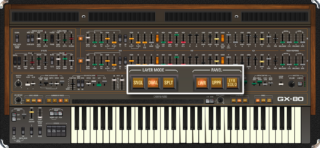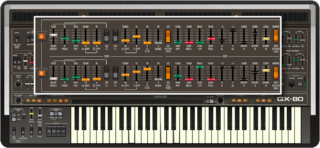Cherry Audio today introduced GX-80, a “transformative virtual synthesizer” that combines the unparalleled sound and features of the fabled Yamaha GX-1 “Dream Machine” and its iconic offspring, the CS-80, to create a powerhouse hybrid virtual instrument.
Featuring the carefully circuit-modeled DSP designs of developer Mark Barton, Cherry Audio says that they have replicated every subtlety of the classics to create the most authentic emulation of its kind.
More than a Replicant
GX-80 integrates the GX-1’s distinctive feature set into the CS-80 architecture; most significantly, the massive dual-layer architecture that effectively made the GX-1 the equivalent of two CS-80s and then some.
The GX-1’s unique highpassed resonant pulse and bandpassed sawtooth waves, octave-up triangle wave, and filter envelope inversion are incorporated, opening up a new universe of sonic experimentation. Most notably, GX-80 includes an reproduction of the legendary GX-1 filter, delivering timbres that even the mighty CS-80 cannot produce.
GX-80 boasts a dual-layer voicing architecture, outfitted with 16 polyphonic voices per layer. The instrument is capable of sounding two different CS-80 style sounds simultaneously, while panning each rank independently, to produce rich stereo timbres and complex, layered sounds. For ultimate flexibility and expressive performance, GX-80 provides a split keyboard mode and an option to simulate polyphonic aftertouch with a monophonic aftertouch controller.
The GX-80 comes with over 1,000 presets and equipped with studio-grade effects.
The Inspirations
In 1973, the most technologically advanced polyphonic synthesizer ever conceived was released. Featuring groundbreaking advances in polyphony, velocity and aftertouch sensitivity, along with four ranks of incredible sound quality, the GX-1 was a quantum leap forward from its contemporaries. It was produced in extremely limited numbers (estimated at around 20) and cost $50,000.
As a result of its immense size, weight, and price tag, The Dream Machine, as it was known, was available only to the most well-heeled professional musicians. Only a handful of these instruments survive today. Notable users of the GX-1 and tracks featuring it included Keith Emerson (“Fanfare for the Common Man”), Stevie Wonder (“Village Ghetto Land”), ABBA (“Lay All Your Love on Me”), and John Paul Jones of Led Zeppelin (“All My Love”).
Four years later, in 1977, the more programmable CS-80 synthesizer was released. More compact and affordable, owing to a single keyboard and two ranks, the CS-80 retained the same basic voicing architecture and innovative real-time performance control capabilities as the GX-1. The CS-80 was embraced by music professionals, including Paul McCartney, Eddie Jobson, Michael Jackson, Peter Gabriel, Hans Zimmer, and Vangelis, who famously made use of its highly expressive real-time performance capabilities in Ridley Scott’s 1982 sci-fi classic, Blade Runner.
Though their outward appearances were radically different, the GX-1 and the CS-80 instruments were very similar under the hood. Both featured a voicing architecture based on “ranks,” wherein each rank was a complete synthesizer voice consisting of an oscillator, highpass and lowpass filters, a noise generator, a sine wave oscillator, a VCA, and envelope generators for both the filter and VCA. The CS-80 included two of these voice ranks, each capable of playing up to eight independent polyphonic notes — a total of 16 synth voices under the hood. The GX-1 featured four of these eight-note poly voice ranks, assignable across two keyboards, plus a single solo synth voice rank for its three-octave mini keyboard and another synth voice rank for the pedalboard.
Unlike the CS-80, the GX-1 was strictly a preset instrument. Though it had no onboard synthesizer parameter controls, its analog synthesizer voicing could only be programmed using an external hardware programmer box through a very elaborate procedure.

On the other hand, the GX-1 had several tricks up its sleeve that were not passed on to the CS-80. The GX-1 oscillator section featured a pulse wave with an adjustable highpass resonator and a sawtooth wave with a dedicated bandpass resonator, in addition to and in parallel with the standard pulse and sawtooth wave outputs. Additionally, it had an adjustable octave-up triangle wave, a filter envelope inversion option, and a VCF comprised of highpass and lowpass filters with such immense range that they are still considered legendary to this day.
More than the Sum of its Parts
A virtual reproduction of the CS-80 has long been the most popular request from Cherry Audio fans. The company began work in 2021 to make the dream a reality. DSP designer and developer Mark Barton’s extensive research of the original CS-80 and its schematics led him back to the CS-80’s predecessor, the indomitable GX-1.
“The CS-80 was loathe to give up all its secrets,” says Mark Barton, whose work on deciphering its audio path was exemplary. “As soon as we found something we thought strange, we immediately verified the behavior on both CS-80s we used for modeling. We then did a deep dive into the schematics to verify why we were hearing what we were hearing.”
As a result, GX-80 combines all of the sonic characteristics of the originals with exceptional accuracy. When enhanced with GX-80’s discrete layer volume and panning controls, the result is a colossal dual-layer voicing architecture, 16 polyphonic voices per layer, with two different timbres simultaneously playable in a split or stacked layer mode.
To provide an experience as close as possible to the original hardware, GX-80 adds a split keyboard mode and support for both polyphonic and monophonic aftertouch controllers. Further, Cherry Audio has added a “last-note priority” mode, for simulated poly aftertouch response with a monophonic channel aftertouch controller.
Introduction to GX-80 Video
Cherry Audio and synthesist Tim Shoebridge have again teamed up for an introductory video to get users up and running:
Pricing and Availability
GX-80 is available now with an intro price of $59 USD (normally $79).








I’ll pass. I already have Arturia’s V Collection 9 with CS-80 V4.
Exciting. The dual layer and GX1 additions take this above and beyond especially at the price. This is my Christmas present to myself. I’ve got the Arturia version and this still offers enough extra to warrant the purchase. I’ve got other Cherry Audio bits and I’m happy with the sound and use ability. I think other videos might tell us a bit more. It will be interesting to see how snappy the envelopes can be- this is 2022 and not 1972/3/4
I support CA stuff so instant buy for me. Was not expecting a GS-1 / CS-80 combo. So even more audio sonic fun. Waiting for CA to release their beer and wooden doll choir, then my life will be complete. 😉
they should do a set of Singing Beer Steins! I’ll drink to that!
I’ll pick one up right after I shake this COVID bout.
Nice – but the thing that sets the GX1 and also – to some extent the CS80 – apart from other synths is what they derived from organ tech. Options for that in a softsynth would be welcome – i.e combinations etc. A GX1 emu need to let you play the thing from 3 keyboards and one full pedal board. (Got this here (four manuals actually) – just waiting for the right software – ok I can to some extent achieve this with a setuo in Cubase being clever with the MIDI.. but then again..)
Hey, Mitch from Cherry here. We briefly considered adding per-rank MIDI channel control, but there wouldn’t have been much real-world advantage over just running multiple instances with different controllers routed, and depending on your DAW, running multiple MIDI channels can be finicky to configure. Also some of the voicing controls aren’t within the ranks (oct range and LFO, mainly) and there wouldn’t have been room to add extra sep controls.
No Linux version 🙁
I have seen this comment under almost every software release for years and keep wondering: Why did you switch to Linux? You must have known that most audio software will never be available on the platform, right?
yeah, kinda obvious by now linux is not priority for anyone but it’s users. I liked it in the 90’s when it was new on the scene, but it’s gone off the rails for a unix knockoff since then.
It totally makes sense for developers to put the work in to a Linux version for the 8 people using Linux to make music, who will then complain because the software isn’t open source.
lol
it dosnt work for windows 98 either
Seriously? It’s a hard pass from me, then.
I’m stepping through the presets and its impressive. Being based on organ tech, as eivind points out, its a keyboard player’s synth more than a complex sound design instrument. That’s amplified by the GX-1 filters. They make it more fun to dig in when you play. The range of motions is a winner. The grand pads and brass are there, but also many things you wouldn’t expect.
AmplifierX: Yep, the envelopes are super-snappy. I had to pull back so I didn’t lose a finger. Its a damned good hybrid.
Thanks for that. Payday is next week, I will pull the trigger then and keep myself busy of the Christmas period.
Thank you
It looks like a mouse-click nightmare to me. There’s nothing more uninspiring than fake hardware GUIs to me.
Since I accidentally discovered that the jog wheel of my Loupedeck CT controls any parameter the mouse is hovering over, plugins are more fun again. But yes, this one has a very busy interface for sure.
If that’s your hot take on a software instrument in the year 2022, then you’re clearly not the intended audience for something like this. They’ve managed to emulate some of the rarest and most costly-to-maintain hardware synthesizers in existence with this. I’ve owned several pieces of hardware that this replaces and I’ll tell you that I’m relieved to finally have this in software form. I have multiple Yamaha Electone organs in storage awaiting repairs with parts I’m unlikely to ever find. For less than half the cost of a single hour of bench labor with my tech, I can now recreate the feel of those near-dead organs I own. For me, this is probably the most exciting new software in a decade.
And I own both the Arturia software and the Deckards Dream. This is so much more than either of those.
Heh, “mouse-click nightmare.” Try a software modular and then come back. You’ll love it then!
I hear you, though. I just wound up ITB because my hardware stack runneth over and became a hassle as much as a fun thing. Almost none of us will ever acquire a real CS-80, much less a bloody GX-1 and a hardware GX-80 would cost a billion bucks in today dollars.
Touch screens aren’t up to speed for me yet, but for all of this power, I’ll use a mouse and call it good. Real good. It sounds as rocking as my iffy memory can dredge up of the one time I got to play a CS-80 in person.
My all time dream synth has always been the GX-1 since I had learned that all my favorite ABBA synth sounds were made using this beautiful synth apart from it being the most beautiful synth ever. So I’ve always been hoping that one day someone would make a GX-1 replica or a plugin. Whilst this is not an GX-1 plugin it is still very nice to see some features of that synth being included here. So thank you Cherry Audio!
Also Synth Stack 3 is available now with this toy and others since Dreamsynth.